Bio PPQs wrong topic 2
1/97
There's no tags or description
Looks like no tags are added yet.
Name | Mastery | Learn | Test | Matching | Spaced |
|---|
No study sessions yet.
98 Terms
Describe the role of tRNA in the production of the protein part of a glycoprotein
each tRNA brings a specific amino acid (to the ribosome)
the tRNA with the complementary anticodon binds to the mRNA codon
tRNA bonds to ribosome
The synthesis of mRNA occurs in a process called transcription. Compare and contrast the process of transcription with the process of DNA replication. (4)
Similarities:
involve the formation of (polynucleotide/phosphodiester bonds
involve DNA helicase
Differences
transcription uses RNA nucleotides whereas replication uses DNA nucleotides
transcription uses RNA polymerase whereas replication uses DNA polymerase
transcription produces single strand of mRNA/only copies template strand of DNA whereas replication produces double stranded DNA/copies both strands of DNA
What is a gene?
a sequence of bases/nucleotides in DNA coding for a {sequences of amino acids/ polypeptide/ protein}
ALLOW section of DNA coding for a sequence of amino acids/polypeptide/protein
most safe: a sequence of bases that codes for a polypeptide
Explain how a change of one amino acids could lead to a change in the structure and properties of the haemoglobin molecule (4)
different {sequence of amino acids/primary structure
(a different amino acid will have a) different R group
(therefore) {secondary/ tertiary/ quaternary} structure will change
(due to a) change in a named bond (holding moelcule in its 3D shape)
(haemoglobin) may not bond to oxygen

Analyse the data to comment on the effectiveness of these antibiotics for the treatment of TB. (6)
Basic information:
all the treatment combinations were effective at treating TB
All treatments had some {relapses/individuals with TB} (3 years later)
{Group 1/group 1 and 2/rifampicin + pyrazinamide/rifampicin + isoniazid} has the lowest number of patients with TB (3years later)
Evidence for linkages made
percentage relapse varies depending on second part of treatment
combinations involving rifampicin most effective
these anitbiotics tested act on different targets in bacteria
gaps in information - not all combinations tested, other combinations might be more effective
other time scales may have been more effective
Evidence for sustained scientific reasoning
could be other reasons for infections with TB 3 years later not due to the antibiotic treatment
no information about dormant TB (only percentage of active cases)
bacterial RNA polymerase possibly the best target for antibiotics
antibiotics targeting synthesis of cell wall fatty acids least effective in terms of relapses
idea of combination of antibiotics with different mode of activity most effective
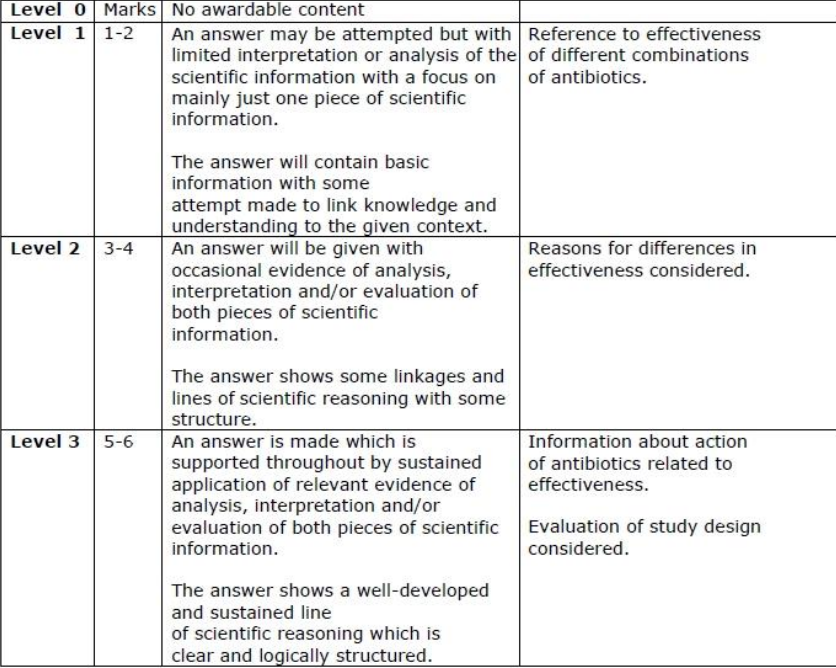
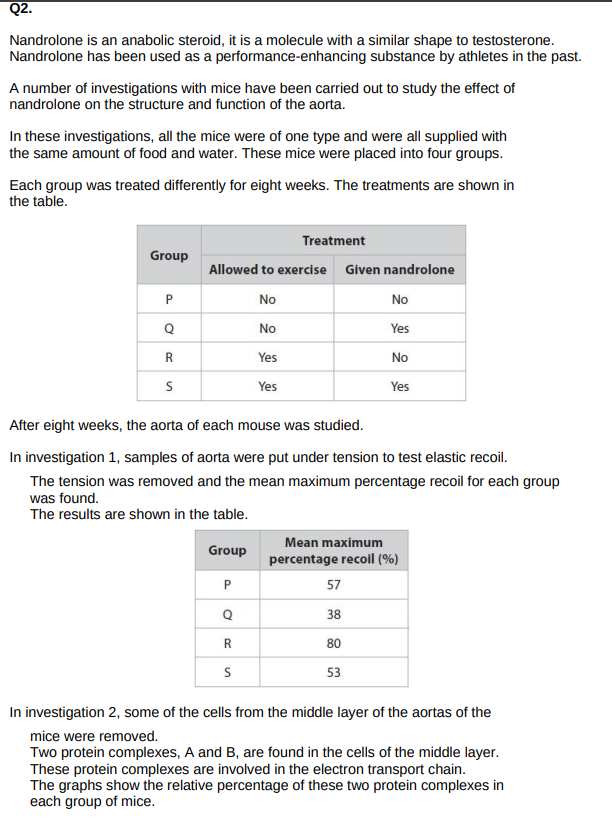
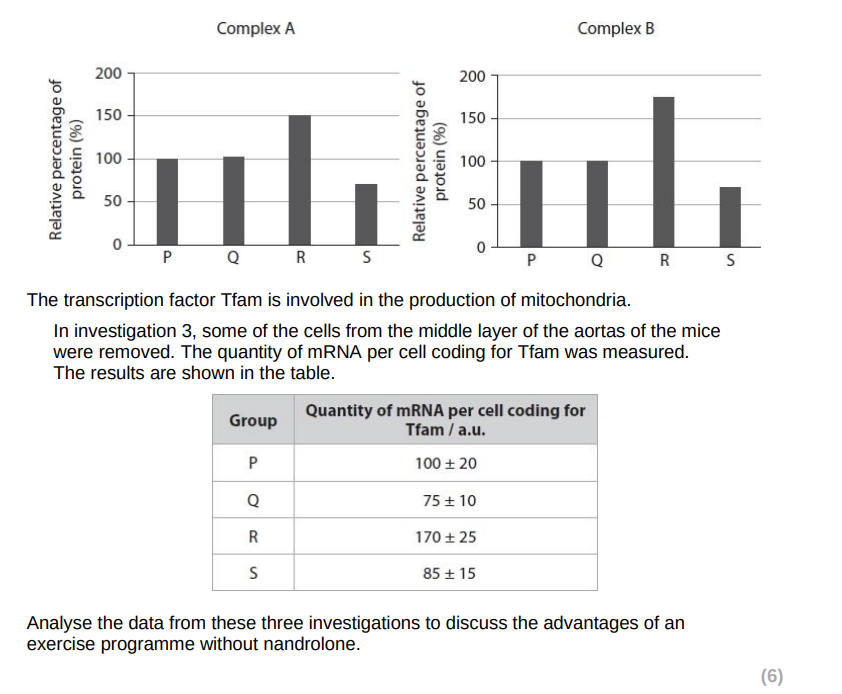
investigation 1
comparison of data for no excercise/excercise without nandrolone: max recoil of {aorta/artery} is {higher /23% greater}
discuss outcome of this difference as an advantage: so (oxygen-rich) blood can flow more rapidly (at the correct pressure) {from the heart/to the muscles}
less likely to get atherosclerosis/ CVD/ strokes
investigation 2
comparison of data for P and R for both protein complexes: more present due to excercise
discuss advantageous outcome: so more {oxidative phosphorylation/ ATP synthesis / chemiosmosis} so more ATP for muscle contraction / breaking of the bond between actin and myosin (in aorta wall)
investigation 3
compare P and Q for mRNA coding for Tfam: more Tfam per cell so more mitchondria produced so more {respiration/ ATP formed}
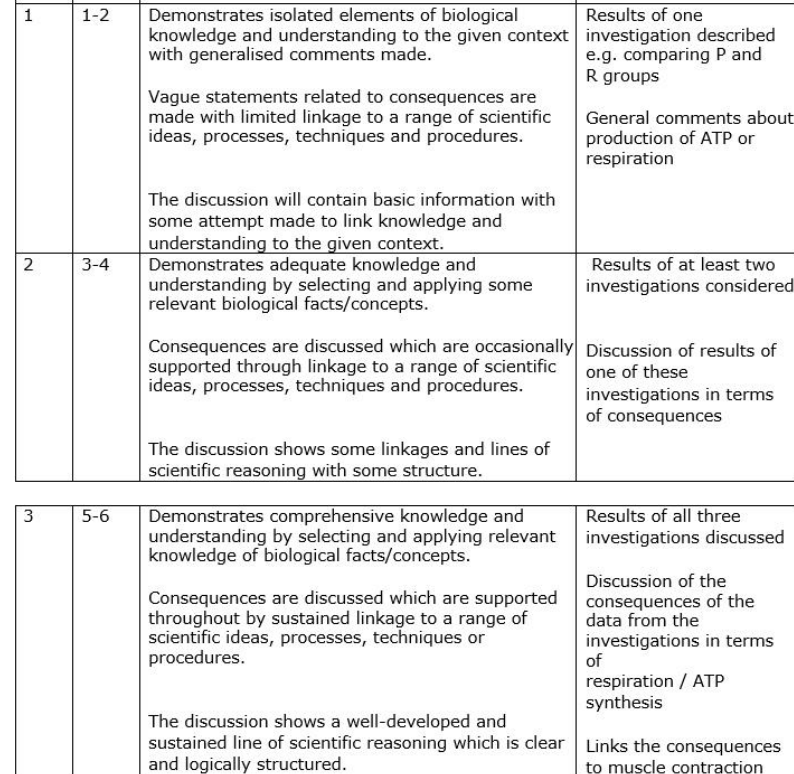
Explain how a change of one amino acid could lead to a change in the structure and properties of the haemoglobin protein (4)
different {sequence of amino acids/ primary structure}
(a different amino acid will have a) different R group
(Therefore) {secondary/ tertiary/ quaternary} structure will change
(due to a) change in a named bond (hydrogen bond, disulfide bridges, ionic bonds DO NOT ALLOW PEPTIDE BONDS) (holding the molecule in its 3D shape)
(haemoglobin) may not bind to oxygen
Describe the role of tRNA in the production of leptin (3)
tRNA molecules {transport amino acids to the ribosomes}
tRNA molecules have an anticodon that {binds to/ recognises} a codon on the mRNA
each tRNA carries a particular amino acid
Describe how the primary structure of leptin allows it to be soluble in water (3)
primary structure/sequence of the amino acids determines the folding of the polypeptide
forming a globular structure
hydrophobic R groups are located in the centre of the protein/hydrophilic R groups are located on the outside of the protein
water forms hydrogen bonds with protein/hydrophilic groups
Leptin is a protein hormone with a role in the control of appetite in humans. Several mutations of the leptin gene have been identified. All these mutations are frameshift mutations that result in shortened primary structures. A frameshift mutation involves the insertion or removal of one or two nucleotides from a gene. Describe how a frameshift mutation could result in the production of leptin with a variety of shorter primary structures. (2)
adding or removing 1 or 2 nucleotides changes the triplet code
introducing a new start/stop codon
coding for a shorter sequence of amino acids
One function of DNA is to act as a template for the synthesis of messenger RNA (mRNA) during transcription. (i) Describe how mRNA is synthesised at a template strand of DNA. (2)
RNA nucleotides align with complementary bases on DNA
RNA nucleotides joined together by RNA polymerase/phosphodiester bonds
Describe the differences between DNA and RNA (3)
DNA is double stranded whereas RNA is single stranded
DNA contains deoxyribose whereas RNA contains ribose
DNA contains thymine whereas RNA contains uracil
Differences between transcription and DNA replication:
replication involves DNA nucleotides whereas transcription involves RNA nucleotides
replication produces double stranded DNA whereas transcription produces a single stranded RNA molecule
replication uses DNA polymerase whereas transcription requires RNA polymerase
replication produces identical copies whereas transcription produces complementary copies

hydrogen

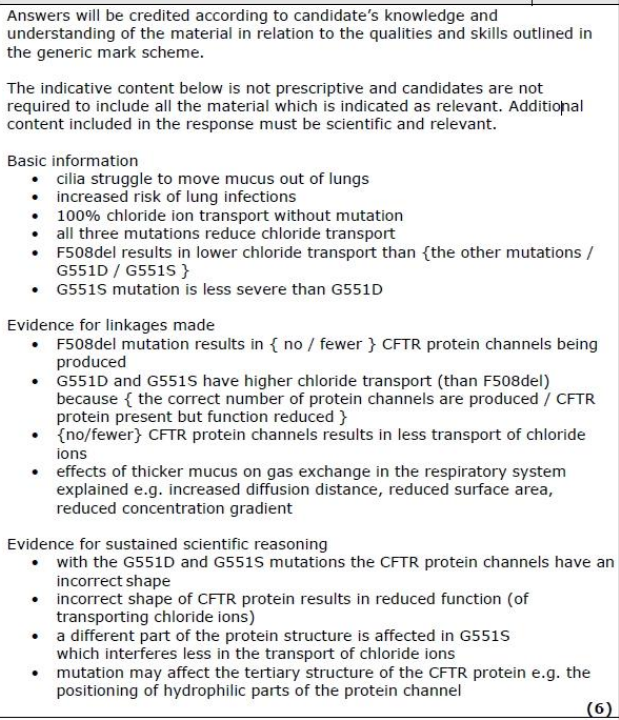

Mutations to DNA can affect the structure of proteins produced in the cell. Removing one base from a DNA sequence will affect the primary structure of a protein. Changing one base for another may not affect the primary structure of a protein. Explain why these two types of mutation have different effects on protein structure. (4)
deletion could affect every codon (on the mRNA/substitution will only affect one codon
deletion is more likely to affect the position of the start/stop codon
deletion results in a different sequence of amino acids/ substitution may not affect the sequence of amino acids
substitution may code for the same amino acid
same amino acid due to the degenerate nature of the genetic code
DNA is a polymer made from monomers called nucleotides. Describe how nucleotides join together to form DNA (2)
condensation reaction
phosphodiester bonds
DNA polymerase
Mutations to DNA can affect the structure of proteins produced in the cell. Removing one base from a DNA sequence will affect the primary structure of a protein. Changing one base for another may not affect the primary structure of a protein. Explain why these two types of mutation have different effects on protein structure. (4)
the conservative model was rejected/the semi-conservative model was accepted
due to generation 1 having a single band which is halfway between N15 and N14
because the DNA has one strand containing N15 and one strand containing N14
in the semi-conservative model further generations would have a band which is halfway between N15 and N14/ no band at N15
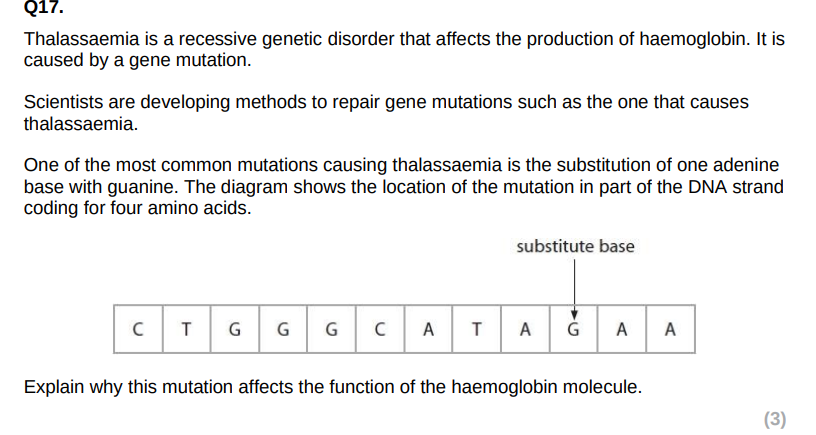
one triplet is affected/ a different triplet code is produced
the mutation could change one of the amino acids
this would change the bonds formed between the R groups/ cause a change in the tertiary structure
the haemoglobin would no longer be able to bond to oxygen
Penicillin is an antibiotic. It was discovered in 1928. Since then many antibiotics have been identified and are widely used in the treatment of bacterial infections. Scientists have recently discovered a new class of antibiotics that bind to ribosomes. (i) Explain why these antibiotics could affect the production of proteins in bacteria. (3)
ribsome shape is altered
mRNA is prevented from binding to ribosome/ causing change in tRNA binding
therefore translation cannot occur
protein/polypeptide is not synthesised
These new antibiotics attach to a site on the ribosome not affected by any known antibiotics. Deduce why these new antibiotics might be used to treat bacteria that are resistant to other antibiotics. (2)
bacteria have not been exposed to new antibiotics before/ bacteria do not have mechanisms to make them resistant to new antibiotics
bacteria have developed resistance to other antibiotics by evolving/ natural selection
therefore there has been no advantage to possessing a mutation to bypass the new antibiotic/ no mutation present to give resistance
* (iii) Scientists have isolated these new antibiotics and tested their effectiveness against bacteria that are resistant to other types of antibiotic. Devise a laboratory procedure to compare the effectiveness of penicillin with one of the new antibiotics.(6)
prepare agar plates with bacterial cultures/bacterial lawn/seeded with bacteria - use bacteria that are resistant to other antibiotics
prepare solutions of new antibiotic and penicillin
place onto paper discs/into wells in the agar/prepare mast rings
control time and temperature of incubation
same concentration and volume of both antibiotics
description of serial dilution of each antibiotic
range of dilutions on each plate one-antibiotic per plate
statistical test to determine which is the most effective
repeat with different strains of resistant bacteria
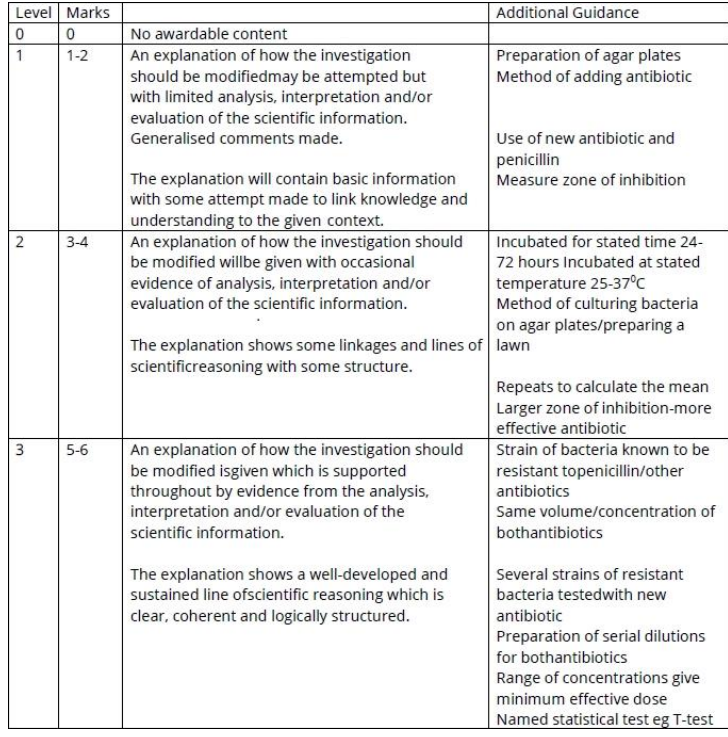
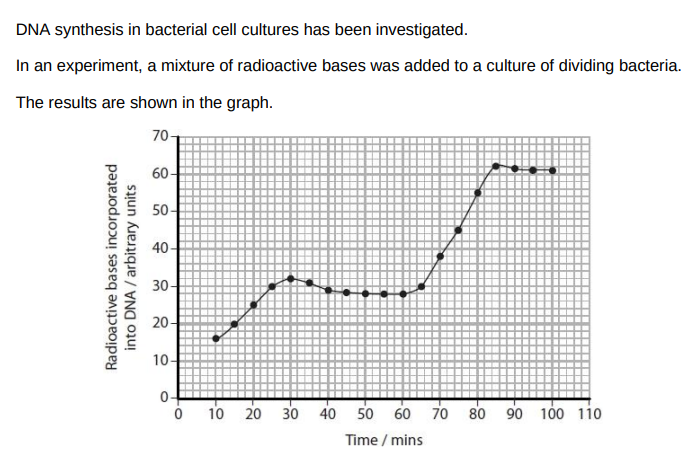
Deduce how many times the bacteria in the culture have divided during this experiment. (2)
DNA content doubles twice/two stages of DNA synthesis
therefore two divisions

Explain why the experiment would be improved if all the bases were provided but only the thymine was radioactive. (2)
because thymine is found only in DNA
other radioactive bases taken up by all nucleic acids
only DNA would be measured
All cells have a cell surface membrane. Some epithelial cells in the lungs secrete mucus. If the mucus is too 'sticky', it cannot be easily removed from the lungs. Other epithelial cells in the lungs contain CFTR proteins in their cell surface membranes. (i) Describe the role of the CFTR protein in ensuring that the mucus produced in the lungs has the right consistency.
chloride ions leave cells (through the CFTR channel protein)
sodium ions leave the cells (following the chloride ions)
increasing the solute concentration in the mucus
water moves out of the cells by osmosis into the mucus

triplet code is shown by 3 bases coding for an amino acid
non-overlapping code e.g. ATT codes for amino acid I and then AAA codes for amino acid K
degenerate code as both ATT and ATC code for amino acid I
Describe the roles of transcription and translation in the synthesis of a globular protein by a muscle cell. (5)
the gene/sequence of DNA for the globular protein is transcribed
complementary base pairing between RNA nucleotides and DNA to produce mRNA
mRNA leave the nucleus and attaches to a ribosome
pairing between codons on mRNA and anticodons on tRNA
tRNA provides specific amino acids
the sequence of bases/codons determines the sequence of amino acids/primary structure of the protein
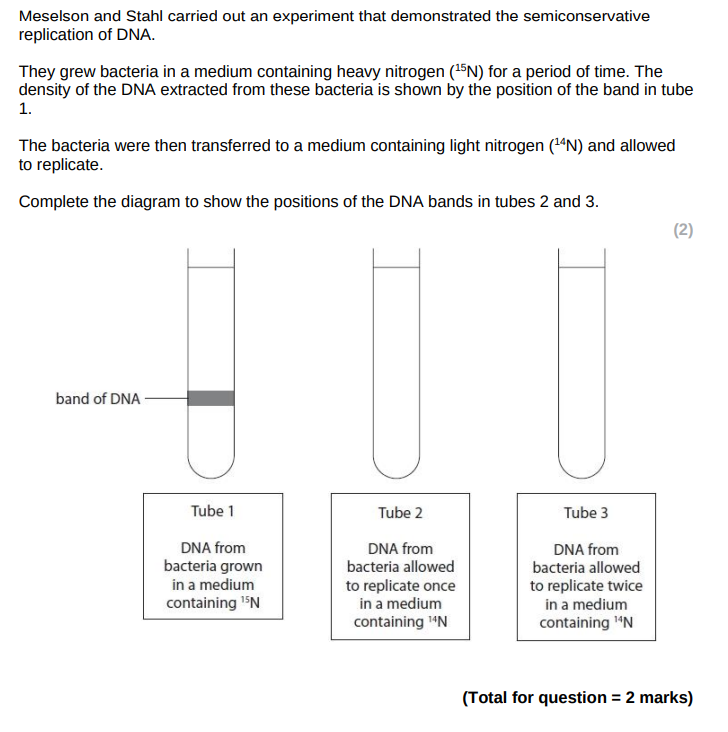
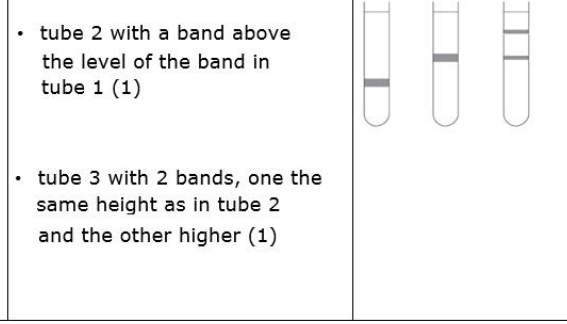
Similarity
both contain phosphate, pentose sugar and a base
Difference
a DNA nucleotide contains deoxyribose whereas ATP contains ribose
a DNA nucleotide could contain other bases whereas ATP contains only adenine/one base type
a DNA nucleotide contains one phosphate whereas ATP contains three phosphates/is a triphosphate
The fluid mosaic model of cell membranes was first proposed in 1972. The vacuoles in beetroot cells contain molecules of betalain, a red pigment. Betalains are large polar molecules. These molecules can leave beetroot cells if the vacuole membrane and the cell surface membrane are damaged. Explain why betalain molecules cannot move through intact cell membranes. (3)
betalain molecules are too large (to move through the cell membrane)
there are no (carrier/chennel) proteins for betalain molecules (to move through)
betalain molecules are polar and (are repelled by hydrophobic fatty acid tails/cannot move through fatty acid tails)
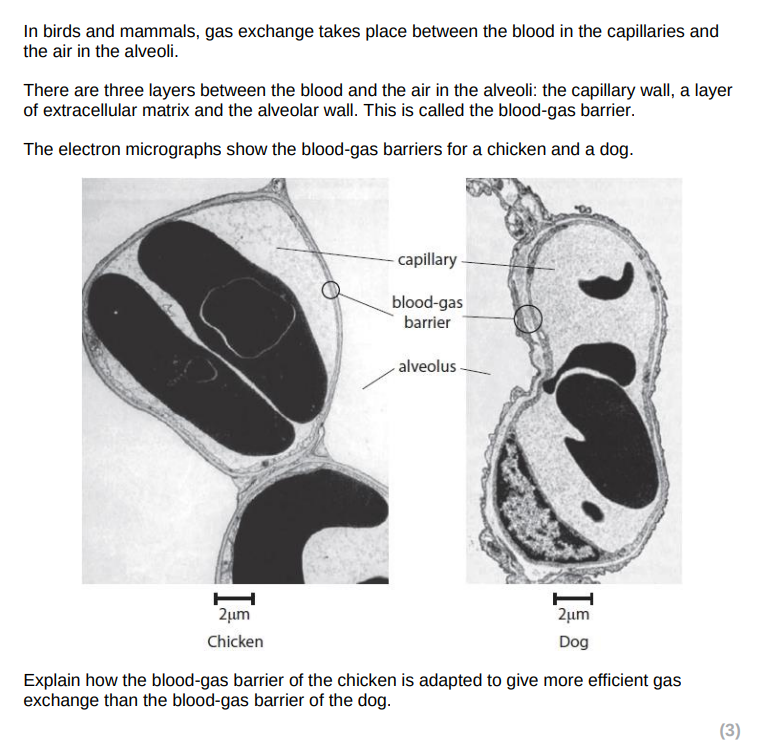
thinner blood-gas barrier
because of thinner (alveolus walls/capillary walls/extracellular matrix layer)
therefore a reduced diffusion distance
a faster rate of (diffusion/gas exchange)

C
Diffusion and active transport are mechanisms by which molecules can enter cells. Compare and contrast these two mechanisms. (3)
similarities
both move molecules through the (phospholipid bilayer/cell surface membrane)
(in both) molecules can move through proteins
Differences
diffusion occurs down a concentration gradient whereas active transport occurs against a concentration gradient
diffusion is a (passive/does not require ATP) whereas active transport requires ATP
Endocytosis and exocytosis are processes that move large molecules into a cell or out of a cell. Compare and contrast the processes of endocytosis and exocytosis. (3)
similarities
both involve vesicles
both processes involve energy from ATP
differences
exocytosis involves (molecules/substances) leaving the cell whereas endocytosis involves (molecules/substances) entering the cell
exocytosis involves vesicles fusing with the cell surface membrane whereas endocytosis involves the formation of vesicles (from the cell surface membrane)
Describe how glucose moves into cells by facilitated diffusion. (2)
carrier protein in cell surface membrane
glucose moves from high to low con
glucose binds to carrier protein which changes shape to move glucose across cell membrane
Explain how the structure of glycogen allows it to be an energy store (3)
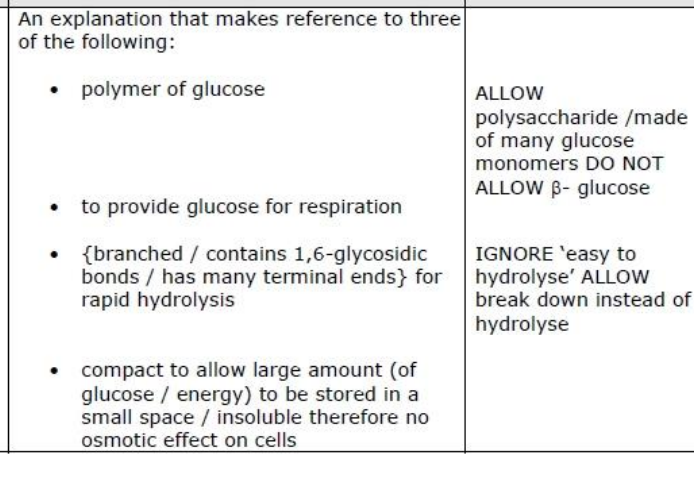
Glycoproteins and phospholipids are molecules found in the cell surface membrane. (i) Give one function of the glycoproteins found in the cell surface membrane. (1)
cell recognition
receptors (on cell surface membrane)
antigens
A cell surface membrane is partially permeable. The phospholipid bilayer is important in controlling the movement of molecules through the membrane. Explain how the structure of a phospholipid molecule contributes to the partial permeability of a cell surface membrane. (3)
contains polar hydrophilic (phosphate_ head and non polar/hydrophobic fatty acid chains
allows fat/soluble/non-polar molecules to pass through the membrane
polar/ionic molecules cannot pass through
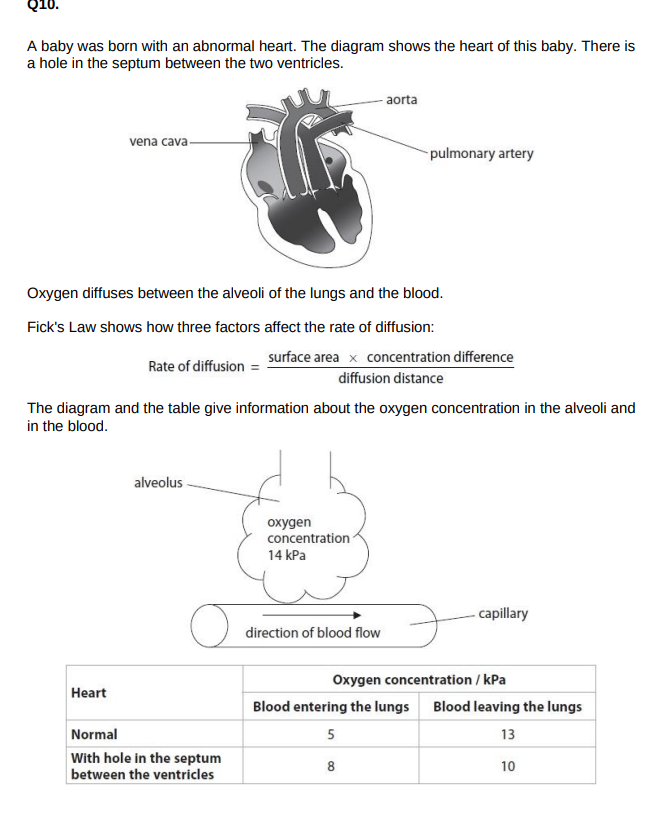
* Assess the effect of this heart defect on the rate of oxygen diffusion between the alveoli and the blood. (6)
rate of diffusion lower with abnormal heart
blood entering lungs from abnormal heart has more oxygen, 8kPa, than blood entering lungs from a normal heart, 5kPa
oxygen in blood increased by only 2kPa instead of 8kPa with abnormal heart
resulting in a smaller difference in concentration between the alveoli and the red blood cells
the surface area of the alveoli and distance is proportional to the rate of gas exchange
a lower concentration gradient for oxygen between the alveoli and the blood results in a lower rate of oxygen diffusion
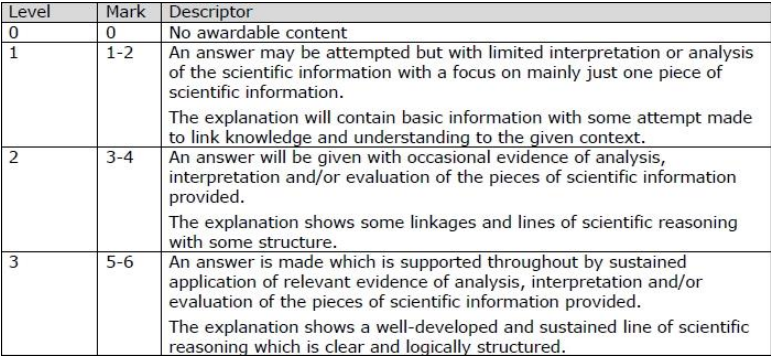

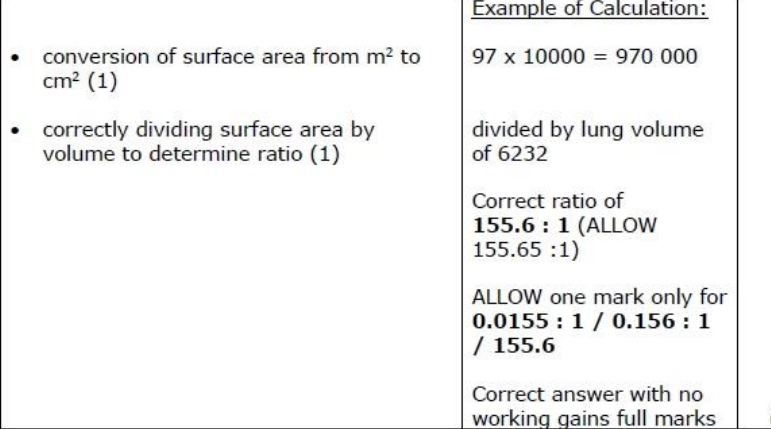
Give reasons for the variation in the lung volumes of healthy individuals.


Give a reason for calculating the surface area for gas exchange to volume ratio in this investigation.
to allow valid comparison/show differences
Blood type is an example of inherited variation. Blood types A, B, AB and O are determined by a single gene. Blood types are due to the presence or absence of antigens on the cell surface membranes of red blood cells. These antigens are glycoproteins. Antigens on the cell membranes of microbes can stimulate endocytosis and exocytosis in white blood cells. These processes are involved in transport through a cell surface membrane. Give two differences between endocytosis and exocytosis. (2)
exocytosis involves molecules/substances leaving the cell whereas endocytosis involves moelcuels/substances entering the cell
exocytosis involves vesicles fusing with cell surface membrane whereas endocytosis involves the formation of vesicles (from the cell surface membrane)
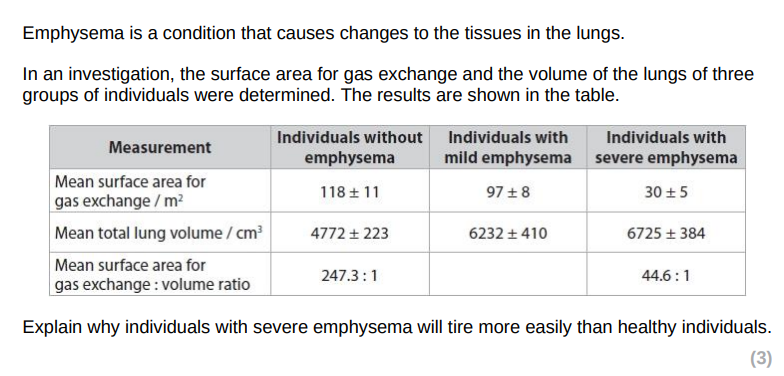
smaller surface area/increased diffusion distance
therefore reduction in oxygen uptake
therefore less oxygen for areobic respiration
leading to more anaerobic respiration
Explain why the phospholipids are arranged in two layers in a cell surface membrane. (3)
hydrophilic region of phospholipid orientated towards water
hydrophobic region away from water
but two layers needed as water based/aq solution either side of the cell membrane
Explain why the phospholipids are arranged in two layers in a cell surface membrane. (3)
involved in facilitated diffusion
movement of large molecules/polar molecules/ions
facilitated diffusion from a high concentration to a low concentration
involved in active transport
needs ATP to move molecules against a concentration gradient

both have the same volume
animal a has a larger surface area
animal a has a larger surface area to volume ratio
so sufficient surface area in animal A for diffusion
distance to cells in centre of A is shorter than for B allowing quicker/sufficient diffusion/shorter diffusion distance
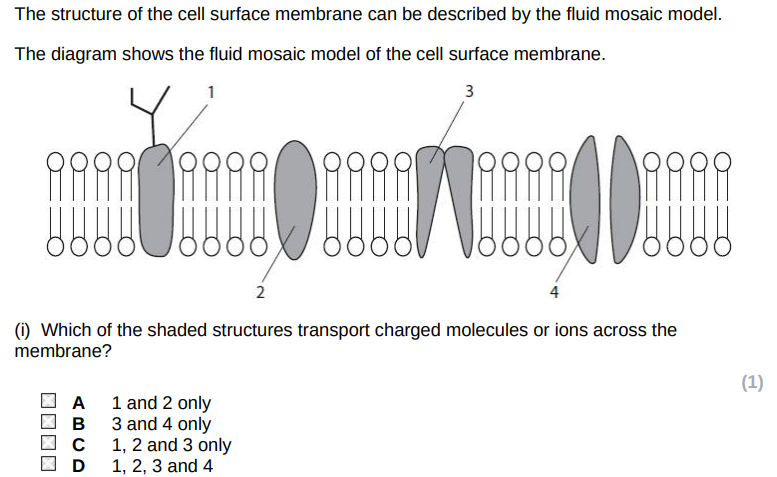
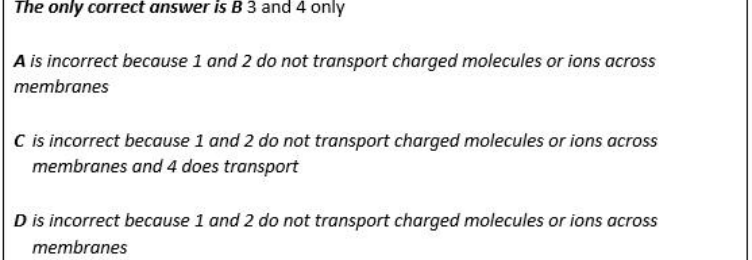
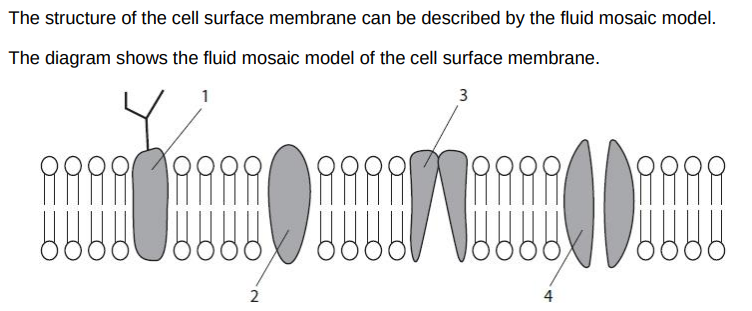
Which of the shaded structures contain both hydrophilic regions and hydrophobic regions? (1)
A 1 and 2 only
B 3 and 4 only
C 1, 2 and 3 only
D 1, 2, 3 and 4
D - 1,2,3,4
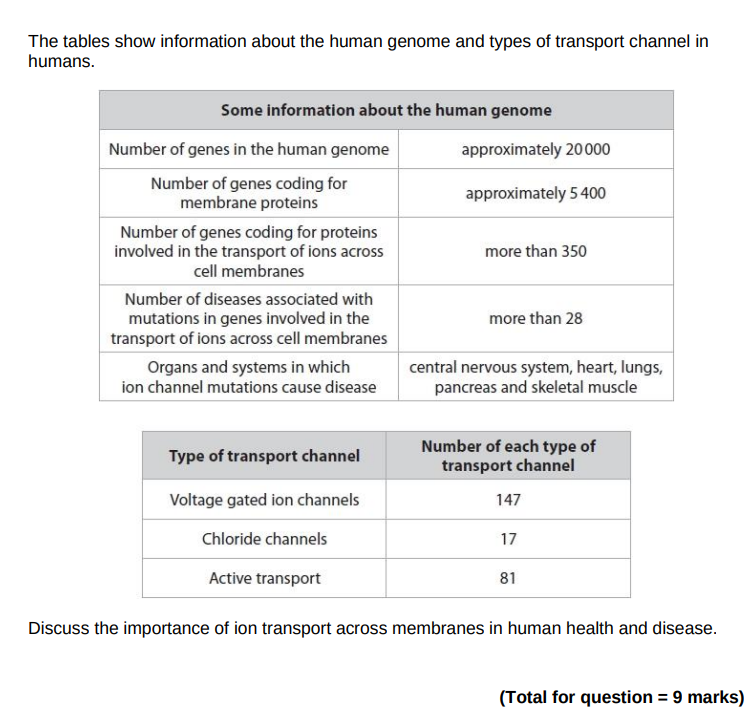
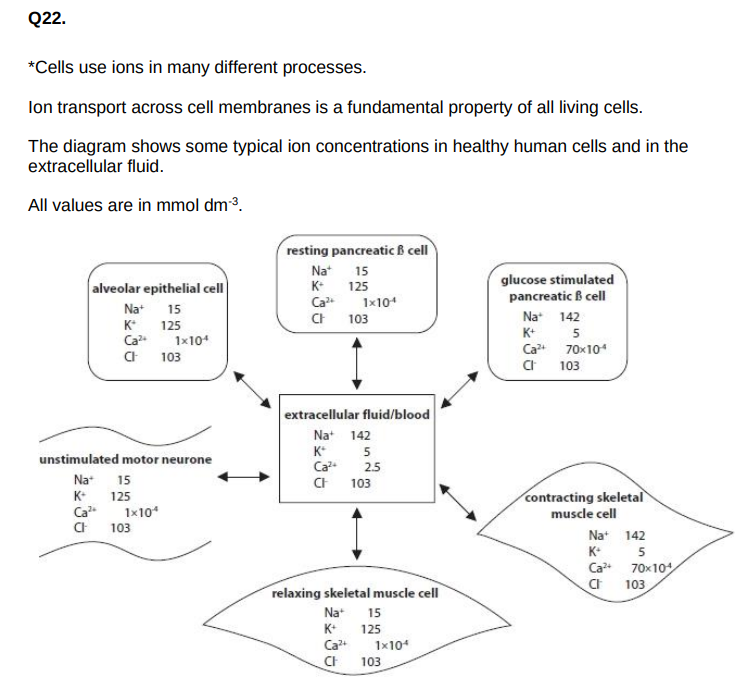
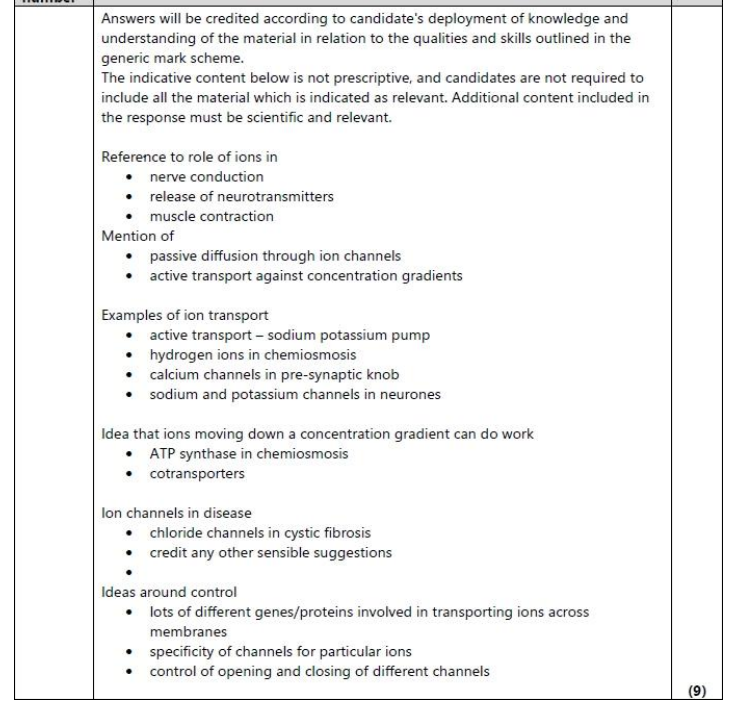
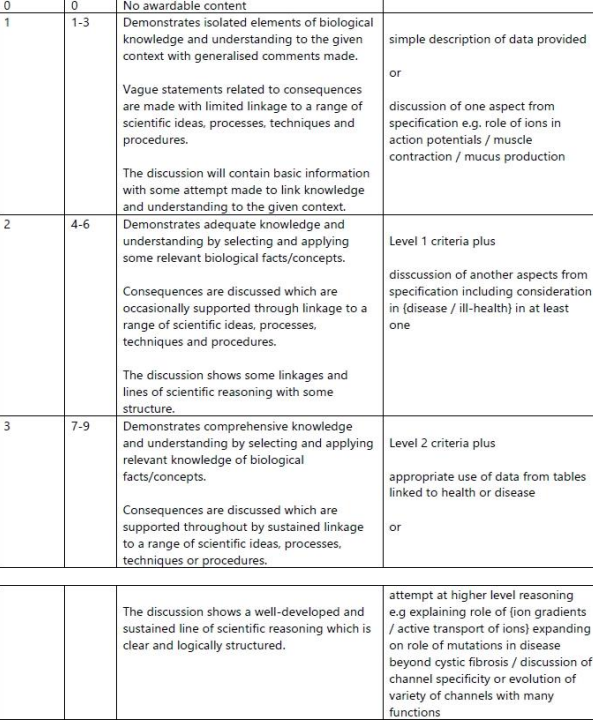
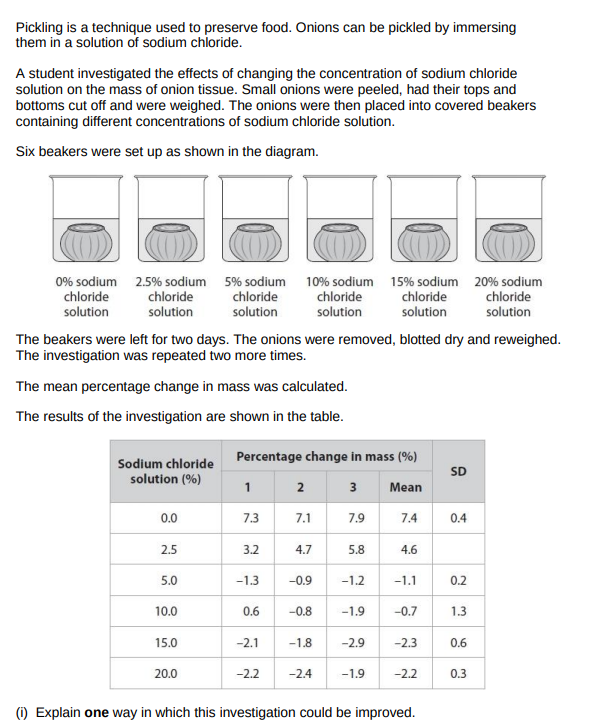
same age/type of onion
increases repeatability/validity
OR
smaller concentration intervals
increases confidence in/ validity of conclusion
OR
same temperature/surface area of onion
due to effect on osmosis
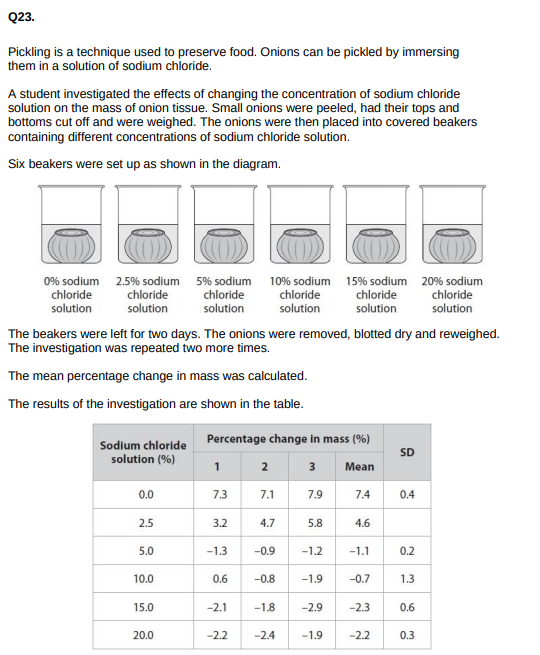
Deduce the effect of increasing the concentration of sodium chloride on the change in mass of the onion tissue. (3)
2.5% sodium chloride solution resulted in an increase in mass
an increase in sodium chloride solution from 5% to 15%/20% resulted in a loss in mass
because of the movement of water by osmosis
SD values overlap for 5% and 10%/10% and 15%/10% and 20%/15% and 20% sodium chloride solution therefore no significant difference


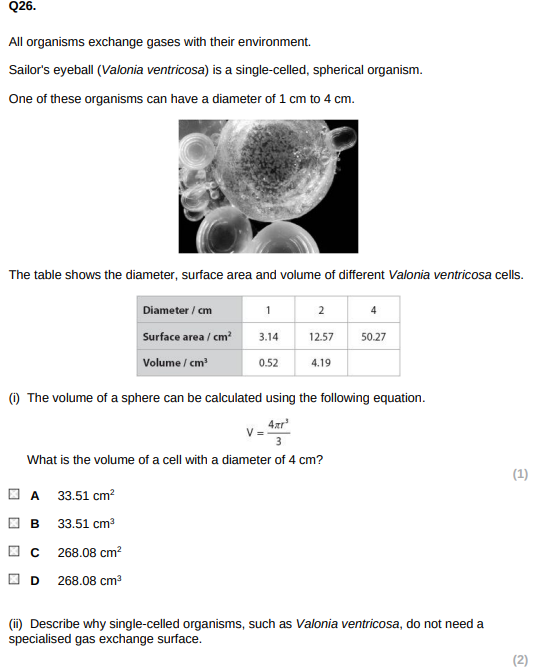
Ignore (i)
they can rely on diffusion to take in oxygen/remove wastes
large surface area to volume ratio (allows diffusion to occur at a sufficient rate)
short diffusion distance
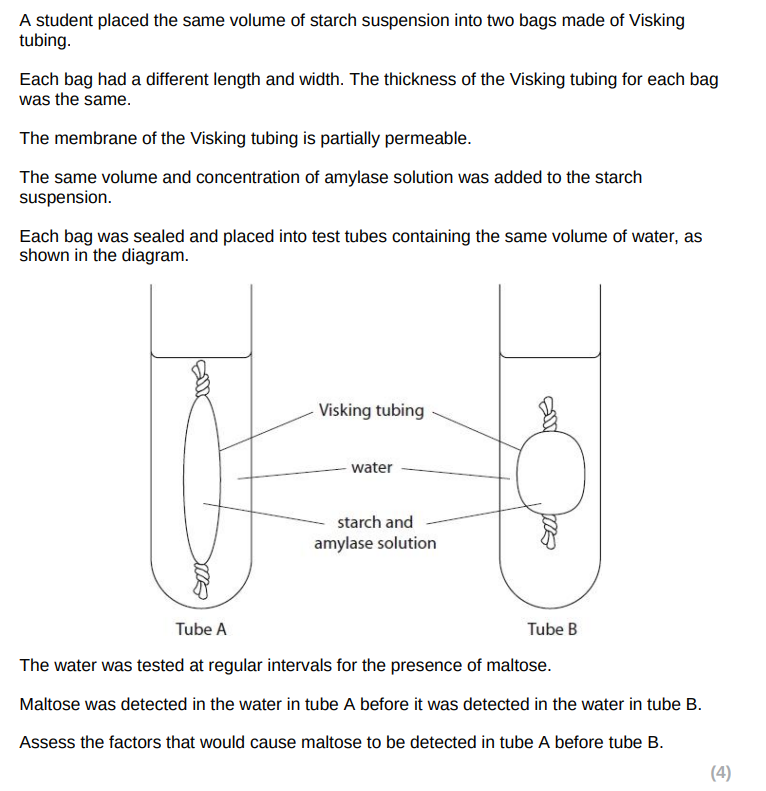
for tube A the surface area was greater than tubing B/ shorter distance for diffusion in tube A
Fick’s law states that rate of diffusion is proportional to surface area/inversely proportional to distance for diffusion
therefore increased rate of diffusion of maltose
tube A could have had a higher concentration of starch/temperature
a higher concentration gradient / higher temperature would increase the rate of diffusion
Hereditary spherocytosis is a condition that affects red blood cells. This inherited condition is caused by a gene mutation that affects the shape of the cell surface membrane. Describe the structure of the cell surface membrane
cell membrane is mainly phospholipids and protein
phospholipids form a bilayer
proteins float in the phospholipids/change position/fluid mosaic model
proteins may span the bilayer or be located in only one layer
Describe the role of tRNA in the production of leptin (3)
tRNA molecules transport amino acids to the ribsomsomes
tRNA molecules have an anticodon that bonds/recognises a codon on the mRNA
each tRNA carries a particular amino acid
Describe how the primary structure of leptin enables it to be soluble in water. (3)
primary structure/sequence of amino acids determines the folding of the polypeptide
forming a globular structure
hydrophobic R groups located in the centre of the protein/hydrophilic R groups located on the outside of the protein
water forms hydrogen bonds with protein/hydrophilic groups
Mutations to DNA can affect the structure of proteins produced in the cell. Removing one base from a DNA sequence will affect the primary structure of a protein. Changing one base for another may not affect the primary structure of a protein. Explain why these two types of mutation have different effects on protein structure. (4)
deletion could affect every codon (on the mRNA)/substituiotn will only affect one codon
deletion is more likely to affect the position of the (stop codon/start codon)
deletion results in a different sequence of amino acids/substituiotn may not affect the sequence of amino acids
substitution may code for the same amino acid
same amino acid acid due to the degenerate code
Explain the importance of the primary structure for the functioning of this enzyme. (3)
determines interaction between (amino acids/R groups)
primary structure determines folding/tertiary structure
therefore affecting the shape of the active site
active site is complementary to ATP
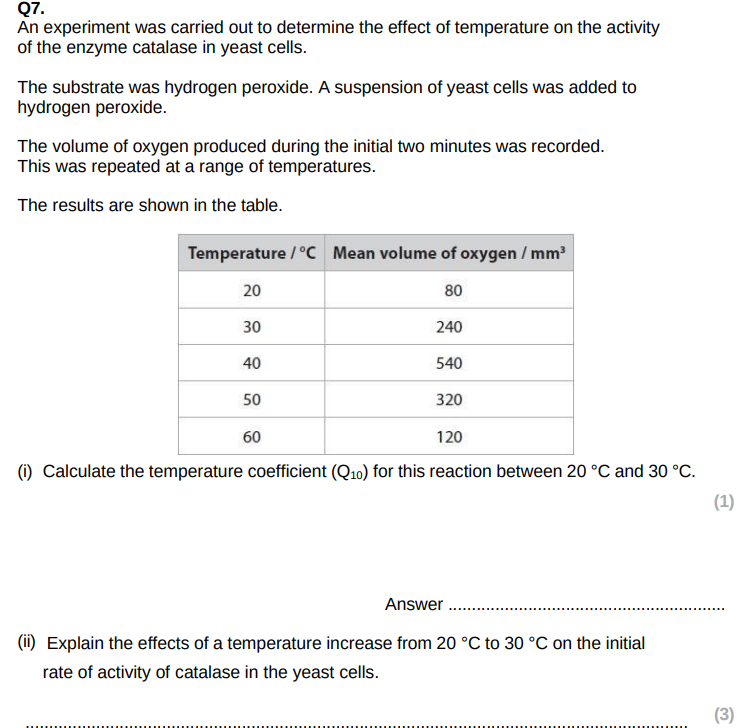
Ignore (i)
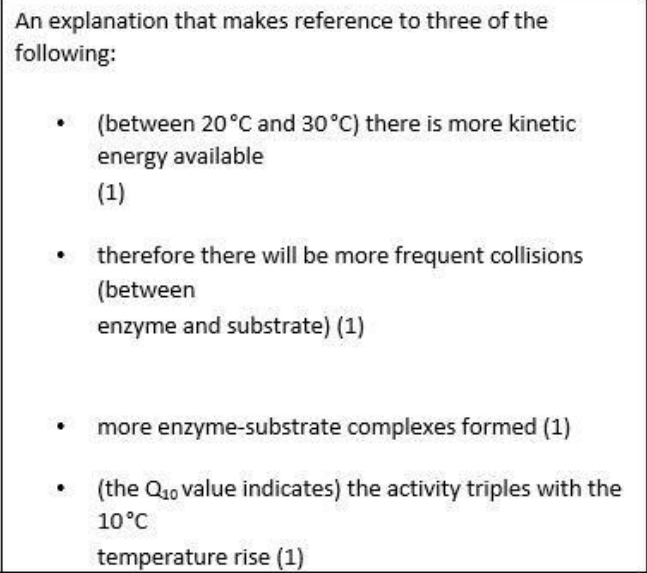
Haemophilia is a disease that affects blood clotting. People with haemophilia are sometimes given a protein called factor VIII. Factor VIII is an enzyme that is involved in the process of blood clotting. Explain how a change in the primary structure of factor VIII could cause difficulties with blood clotting. (4)
different primary structure results in a different sequence of amino acids
change in R groups changes folding/bonding/secondary structure/ tertiary structure
changing shape/charge of the active site prevents substrate from being able to bind
stopping/reducing the production of fibrin
State why enzymes are described as biological catalysts.
proteins which reduce activation energy of biological reactions
Explain how a single base mutation can lead to an altered primary structure of enzyme G. (3)
changing a base results in a change in the triplet code
this changes the codon in the mRNA
resulting in a different amino acid/amino acid sequence in the primary structure
Explain how human genome sequencing can be used to identify the mutations associated with MPS I.(3)
sequence the genome of people with MPS1
sequence the genome of a number of people without the condition
compare the base sequences to identify mutations found only in individuals with the condition
Many of the proteins synthesised become extracellular enzymes. Describe what happens to these proteins following the process of translation until they are released from the cell. (3)
proteins are folded in RER
proteins are packaged into/transported in vesicles
the proteins is modified in the golgi apparatus
exocytosis
Cells in people with these diseases produce incorrectly folded enzyme molecules. Explain why enzymes that are incorrectly folded cannot carry out their function (3)
if the protein is not folded correctly the tertiary structure/3D shape would be different
therefore the active site of the enzyme would not fit/bind with the substrate/ it would not be able to form an enzyme substrate complex
therefore it would not be able to catalyse the reaction


Muscle cells contain globular and fibrous proteins. Compare and contrast the molecular structures of globular and fibrous proteins. (4)
both are chains of amino acids joined by peptide bonds
both contain named (hydrogen bonds, ionic bonds, disulfide bridges) bonds (holding molecule in its 3D shape)
globular proteins have hydrophilic groups on the outside whereas fibrous proteins have hydrophobic groups on the outside
globular have tertiary or quaternary structures whereas fibrous proteins have little or no tertiary structure
globular are folded into compact shapes whereas fibrous have long chains
Explain how a change of one amino acid could lead to a change in the structure and properties of the haemoglobin protein. (4)
different sequence of amino acids/primary structure
a different amino acid will have a different R group
therefore secondary/tertiary/quaternary structure will change
due to a change in a named bonds (hydrogen bonds, ionic bonds, disulfide bridges) holding the molecules in its 3D shape
haemoglobin may not bind to oxygen
Some species of bacteria have developed resistance to antibiotics. This has led scientists to investigate many molecules for antimicrobial properties. Peptides extracted from broad bean plants and cowpea plants have been studied. Describe how a peptide bond is formed. (2)
a peptide bond is formed by a condensation reaction
between the amine group/NH2 and the carboxyl group/COOH of adjacent amino acids

the structure of the enzyme is determines by the sequence of amino acids
tertiary structure provides an active site
to break ester bonds/bonds between glycerol and fatty acids
relevant detail concerning bonding within the enzyme molecule/ between enzyme and substrate (e.g hydrophilic R groups/hydrophobic R groups)
The scientific article you have studied is adapted from National Geographic. Use the information from the scientific article and your own knowledge to answer the following questions. Gene drives can be used to 'force almost any genetic trait through a population' (paragraph 16). Multiple genetic crosses were carried out between individuals homozygous for a recessive allele and individuals heterozygous for the same gene. Describe how the outcome of these crosses would be affected if a gene drive was used with the recessive allele (3)
without a gene drive the expected outcome would be 50% heterozygous and 50% homozygous recessive offspring
with gene drive the proportion of homozygous recessive offspring would increase
the stronger the gene drive the greater the proportion of homozygous recessive
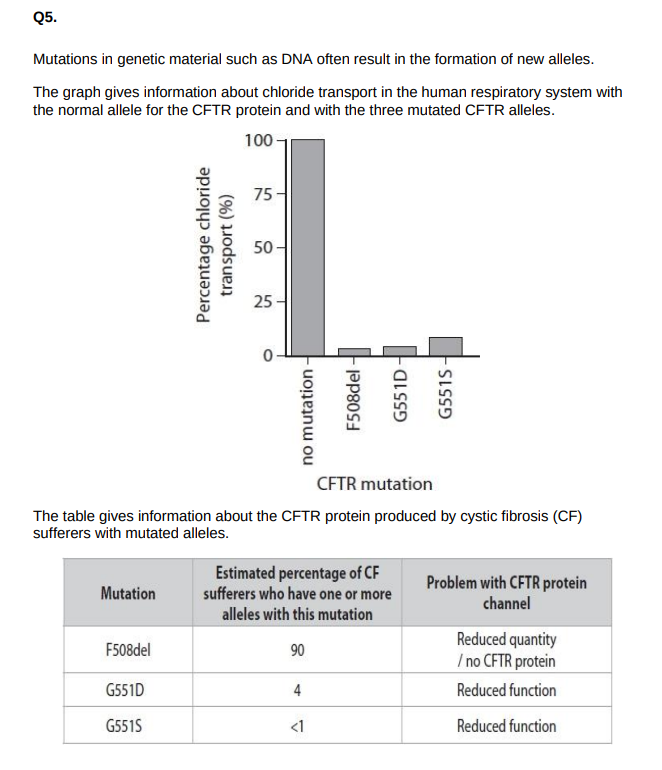
Basic information
cilia struggle to move mucus out of lungs
increased risk of lung infections
100% chloride ion transport without mutation
all three mutations reduce chloride transport
F508del results in lower chloride transport than (the other mutations G551D/G551s)
G551S mutation is less severe than G551D
Evidence for linkages made
F508del mutation results in no/fewer CFTR protein channels produces
G551D and G551S have higher chloride transport than F508del because the correct number of proteins channels are produced/ CFTR protein present but function reduced
no/fewer CFTR protein channels results in less transport of chloride ions
effects of thicker mucus on gas exchange in the respiratory system explained e.g. increased diffusion distance. reduced surface area, reduced concentration gradient
Evidence for sustained scientific reasoning
with the G551D and G551S mutations the CFTR protein channels have an incorrect shape
incorrect shape of CFTR protein results in reduced function of transporting chloride ions
a different part of the protein structure is affected in G551S which interferes less in the transport of chloride ions
mutation may affect the tertiary structure of the CFTR protein e.g. the position of hydrophilic parts of the protein channel
The food we eat contains carbohydrates, lipids and proteins. * People with cystic fibrosis require a higher energy diet than people without cystic fibrosis. They are also more likely to develop problems in the pancreas. Men with cystic fibrosis are less likely to be able to release sperm. Discuss why a person with cystic fibrosis could have these symptoms. (6)
mucus is thicker/sticker than normal
pancreatic enzymes cannot enter intestine because pancreatic duct blocked with mucus
high energy diet required because digestion is less efficient
pancreatic enzyme trapped behind mucus damage pancreatic cells such as those that produce insulin
cysts form in pancreas
sperm cannot leave testes because sperm duct/vas deferens / tubes blocked with mucus
sperm duct/vas deferns absent therefore sperm cannot pass through
gene mutation
causing a non-functioning CFTR protein chennel
chloride ions cannot move out of epithelial cells
accumulation of sodium and chloride ions in the cells causing water to move out of mucus by osmosis/preventing water moving into mucus
Cystic fibrosis is a condition that affects breathing. Explain why cystic fibrosis affects the rate of oxygen uptake in the lungs. (3)
thick / sticky/ viscous mucus
accumulation of mucus which cannot be moved by cilia
restricting air flow through bronchioles/ bronchi
increases diffusion distance/ reduces surface area for gas exchange in the alveoli
Mutations in genetic material such as DNA often result in the formation of new alleles. More than 1500 mutations have been found for the gene that codes for the production of the CFTR channel protein. Some of these mutations cause cystic fibrosis by affecting the production or functioning of the CFTR channel protein. If the functioning of the CFTR channel protein is impaired, thicker mucus is produced in the lungs. Explain why thicker mucus is produced if the functioning of the CFTR channel protein is impaired (2)
chloride ions cannot leave the cell/enter mucus through the CFTR protein channel
sodium ions do not move out of the cells into the mucus
therefore water moves into cells / moves out of mucus by osmosis
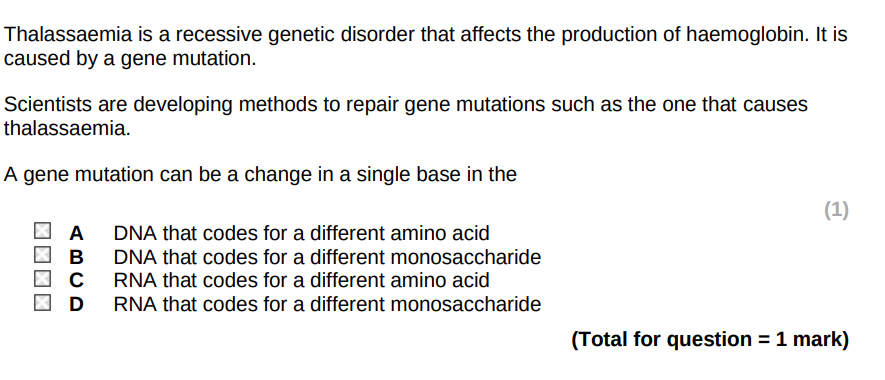
A
Explain why different mutations in the CFTR gene can lead to differences in the severity of the symptoms of cystic fibrosis. (2)
different mutations will have different effects on the protein produced
chloride ion transport affected by the extent of the changes to the CFTR protein
varying the stickiness / thickness of the mucus
Doctors give dietary supplements and digestive enzymes to children with cystic fibrosis. Dietary supplements include carbohydrates, proteins and lipids, as well as vitamin and mineral supplements. Explain why these children would be given dietary supplements and digestive enzymes. (5)
cystic fibrosis causes the production of thicker/stickier mucus
which blocks the pancreatic duct / prevent pancreas enzymes reaching intestine
reduces / prevents enzymes digesting carbohydrates / lipids / proteins in intestines
resulting in reduced absorption / concentration of products of digestion into the bloods / lymph
linkage of reduced amino acid/ vitamins / minerals to slower growth rate
dietary supplements / digestive enzymes would increase growth rate
All cells have a cell surface membrane. Some epithelial cells in the lungs secrete mucus. If the mucus is too 'sticky', it cannot be easily removed from the lungs. Other epithelial cells in the lungs contain CFTR proteins in their cell surface membranes. (i) Describe the role of the CFTR protein in ensuring that the mucus produced in the lungs has the right consistency. (3)
Chloride ions leave cells through the CFTR channel protein
sodium ions leave the cells following the chloride ions
increasing the solute concentration in the mucus
water moves out of the cells by osmosis into the mucus
True or false the CFTR protein is a channel protein
True
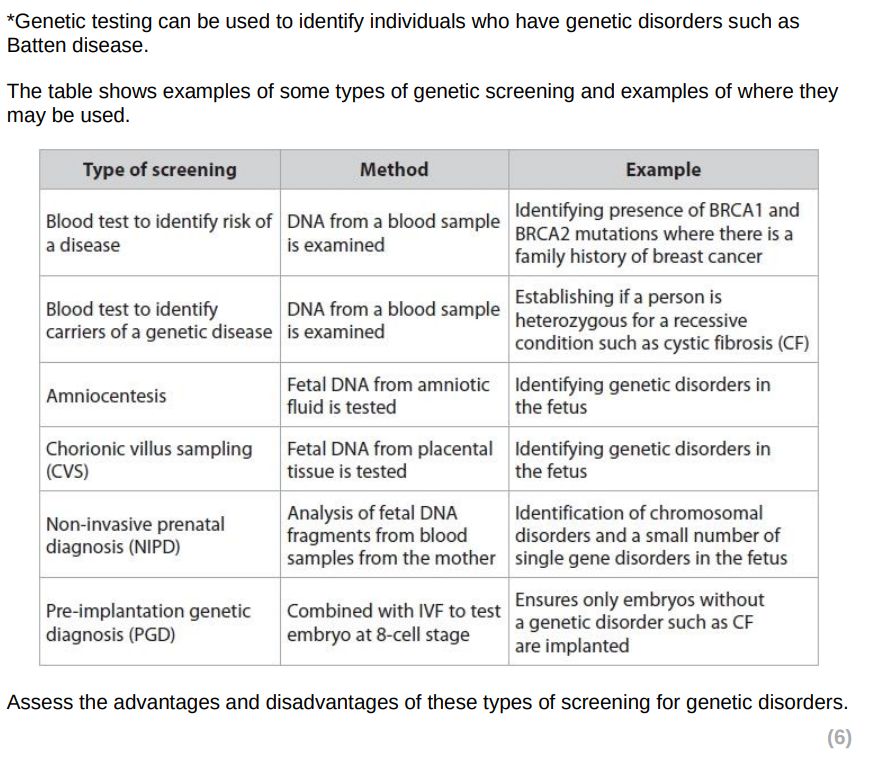
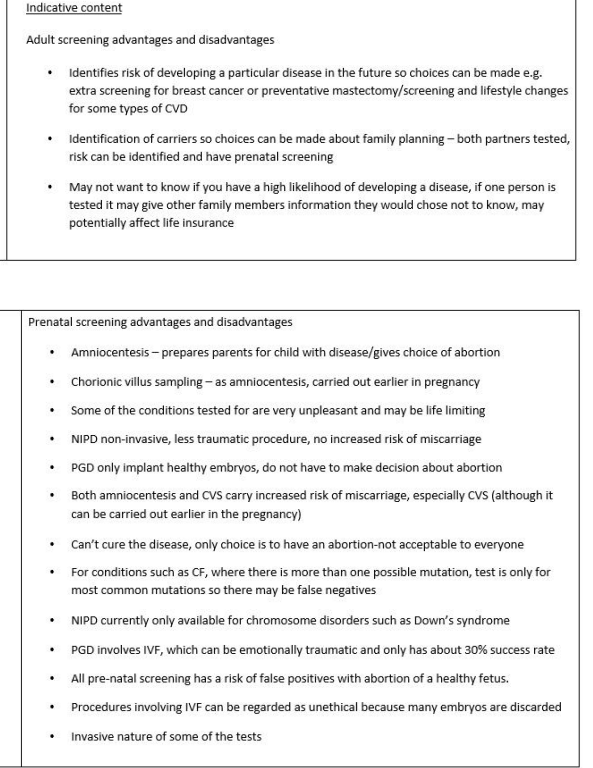
Tay-Sachs disease can be detected during pregnancy. Name the prenatal test that could be used to detect Tay-Sachs disease at 11 weeks of pregnancy. (1)
Explain why this couple may choose not to have this test. (3)
chronic villus sampling
test result may be inaccurate
increased risk of miscarriage due to the procedure
false positive may lead to termination of healthy fetus
prenatal testing / abortion against values or beliefs of the parents
Explain what is meant by an inherited recessive disorder
caused by a faulty allele
that is only expressed in the homozygous condition / absence of a normal allele
If one flower is red and another is white and its offspring is pink what is the type of inheritance?
incomplete dominance

incomplete dominance
allow incomplete dominance
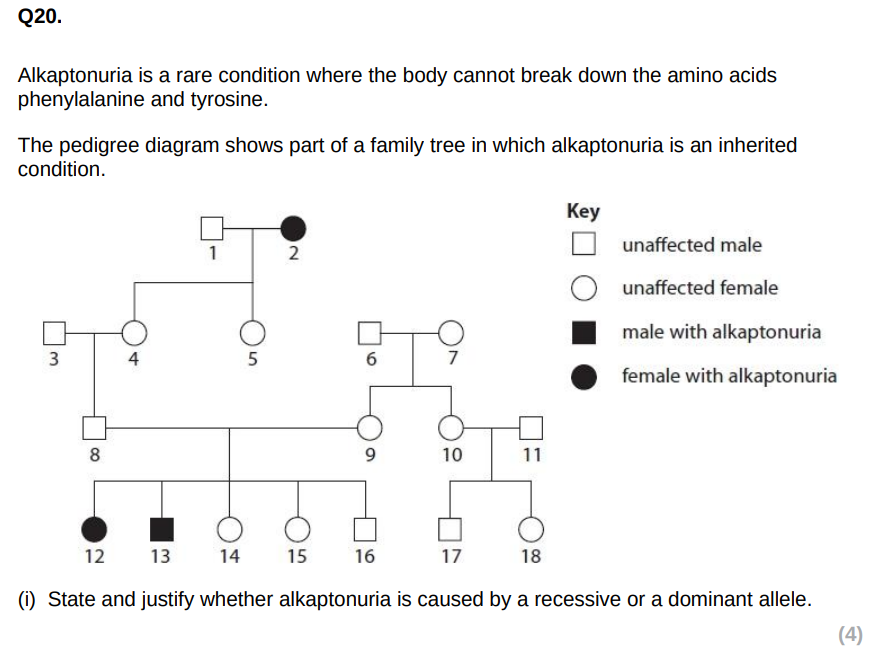
recessive
2 recessive alleles are needed to have condition
individuals 8/9 do not have it but some of their children do
therefore individuals 8 and 9 must be heterozygous
Individual 12 is pregnant and wants to know if her baby has alkaptonuria. State and justify a suitable method of collecting cells for prenatal testing. (3)
EITHER
chorionic villus sampling
cells / tissue taken from placenta / chroionic villus between 10 -14 weeks of pregnancy
benefit of earlier diagnosis
OR
amniocentesis
amniotic fluid containing cells collected between 14-20 weeks of pregnancy
lower risk of miscarriage
State what is meant by the term allele (2)
alternative form of a gene
found at the same locus on a chromosome
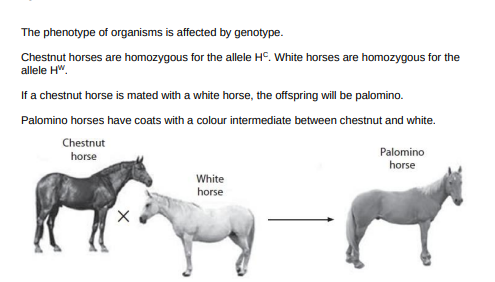
Explain why the offspring have the palomino coat colour. (3)
palomino / offspring is heterozygous
therefore incomplete dominance / co-dominance occurs
because both alleles are expressed
Name the place in the eukaryotic cell where mRNA will be synthesised?
Nucleus
(d) Achondroplasia is an inherited condition that results in restricted growth in humans. This condition is caused by a dominant allele (A). Fetuses which are homozygous for the allele for achondroplasia are rarely born alive. Two parents who both have achondroplasia would like to have children. They are concerned about the risk of their child inheriting two dominant alleles and dying before birth. (i) Describe one advantage and one disadvantage to these parents of genetic screening of their fetus. (2)
Advantage
prevents child dying late in pregnancy
less stress for parents
parents can prepare for child (with / without achondroplasia
idea of making an informed choice
Disadvantage
risk of miscarriage of healthy child
idea of more stress for parents
cost
risk of false negative / positives
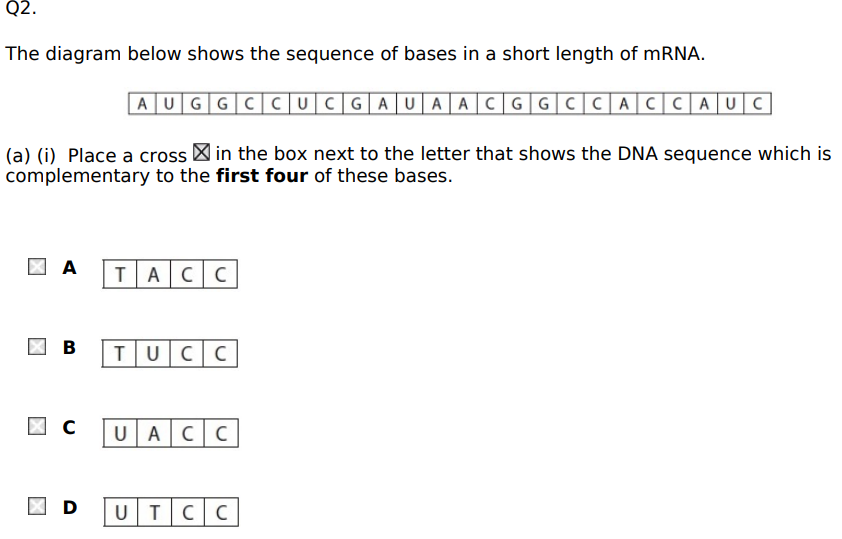
A
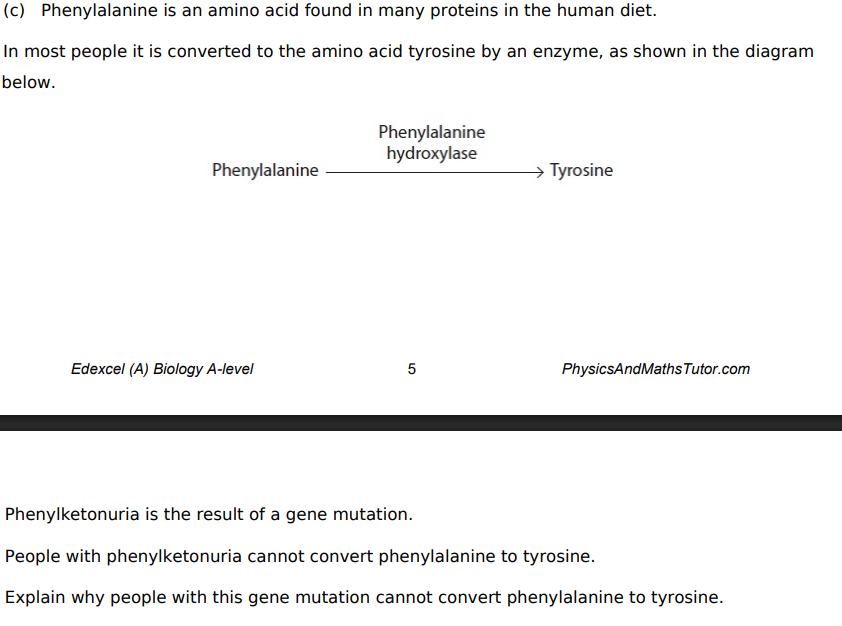
(4)
change in DNA sequence / base sequence of a gene
change in amino acid/ change in primary structure of protein / enzyme
reference to different R groups
leading to different type / position / bonding
idea of change in shape / protperies of active site
idea of substrate does not fit in enzymes active site]#
Describe how transcription is involved in the synthesis of an enzyme. (4)
DNA unzips and hydrogen bonds between complementary strands are broken
the antisense / coding / template strand is used for mRNA synthesis
RNA polymerase is used to join RNA nucleotides
Complementary base pairing of A with U, not T
Explain the nature of the genetic code (2)
triplet code / 3 bases to each code
reference to adenine, thymine, guanine and cytosine
idea that each triplet of bases codes for one amino acid
idea that code is non-overlapping
idea that code is universal
idea that code is degenerate